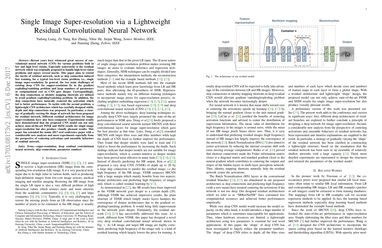Single Image Super-resolution via a Lightweight Residual Convolutional Neural Network
Recent years have witnessed great success of convolutional neural network (CNN) for various problems both in low and high level visions. Especially noteworthy is the residual network which was originally proposed to handle high-level vision problems and enjoys several merits. This paper aims to extend the merits of residual network, such as skip connection induced fast training, for a typical low-level vision problem, i.e., single image super-resolution. In general, the two main challenges of existing deep CNN for supper-resolution lie in the gradient exploding/vanishing problem and large numbers of parameters or computational cost as CNN goes deeper. Correspondingly, the skip connections or identity mapping shortcuts are utilized to avoid gradient exploding/vanishing problem. In addition, the skip connections have naturally centered the activation which led to better performance. To tackle with the second problem, a lightweight CNN architecture which has carefully designed width, depth and skip connections was proposed. In particular, a strategy of gradually varying the shape of network has been proposed for residual network. Different residual architectures for image super-resolution have also been compared. Experimental results have demonstrated that the proposed CNN model can not only achieve state-of-the-art PSNR and SSIM results for single image super-resolution but also produce visually pleasant results. This paper has extended the mmm 2017 oral conference paper with a considerable new analyses and more experiments especially from the perspective of centering activations and ensemble behaviors of residual network.
PDF Abstract



 Urban100
Urban100